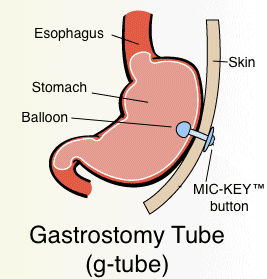Changing a gastric feeding tube also known as a g-tube (sometimes gastrostomy tube), is an area of uncertainty that always seems to generate questions among the MLD Family. Since there is nothing unique about MLD with regard to g-tubes so I though I would share a series of photos to help anyone who want to know what a g-tube is, what a MIC-KEY™ button looks like, and how easy it is to change (or in an emergency replace) a g-tube.
Of course, have a g-tube placed the first time requires a doctor’s intervention and usually some form of anesthesia. (With MLD we recommend as low a dose of anesthesia as possible). We feel that in many cases the periodic changing of a g-tube can be done at home. While intimidating the first time, it’s generally safe, simple and quick. Check with your GI doctors for guidance in your specific situation.
There are several types tubes and of “endings” you can have for a g-tube where it exits the stomach. A gastrojejunostomy or GJ feeding tube is a combination device that includes access to both the stomach and the jejunum, or middle part of the small intestine. GJ tubes are NOT changed by the family, they require a doctor.
These pictures show the basic g-tube of the type known as a percutaneous endoscopic gastrostomy (PEG) tube with a MIC-KEY™ button from Kimberly-Clark. Please refer to the written instructions for other usage questions and while looking that these reference pictures.

Here’s a cross-section of what a g-tube looks like in the belly. Note the inflated balloon that keeps the tube from coming out through the stoma (the hole through the stomach and skin):
You may click on any of the following pictures to enlarge it.

Let’s start with a look at what a g-tube with MIC-KEY™ button looks like in an adult belly:

And this is what the g-tube with MICKEY™ button looks like from the side:

This is some of what is in the MIC-KEY™ button kit:
Let’s Get Started Changing a G-Tube
First, relax and don’t worry. The old tube will look a big grungy after being in the stomach for a few months but you do not need to worry about liquids and “stuff” gurgling out. The stoma will not close during the 2-minute process of a change.
The fine print … Always follow your doctor’s and manufacturer’s instructions – these photos are for guidance only. A few more things …
- Most families can change their g-tubes at home – but please, check with and get trained by your GI doctor before you start doing this yourself – your circumstances may be different.
- Please make your first g-tube change in the presence of your GI doctor or nurse to learn the process with hands on supervision.
- Always test inflate the new tube’s balloon before using it.
- If the new g-tube is not inflating or holding water after you have inserted it, leave it in the stoma deflated, and tape the MIC-KEY™ button down so it does not come out while you seek medical assistance. Head immediately to your local doctor or ER for quick assistance. As long as something is in the stoma, it’s not normally a 911 emergency. The stoma will close fairly quickly if something is not in it to keep it open. If you are uncertain call 911.
- Change the g-tube when the patient is calm and has a settled stomach, i.e. before, not right after meal time.

Important: Before you get started removing the old tube, you need to test inflate the new tube’s balloon to check for leaks by using the small syringe in the side port and the manufacturer’s suggested amount of water. If the balloon holds the water without leaking, deflate it by removing the water. If the balloon leaks DO NOT USE this button.
Now is also a great time to check that the size of the old tube and the new tube are the same by comparing the writing on the top of the button. If they don’t match DO NOT change tubes without checking with your GI doctor first.

First we need to deflate the balloon in the old tube by removing the water from the side port. Using an empty syringe, pull out gently on the plunger to remove the old water:

Almost all removed. It is not unusual to find less water in the balloon than what you put in a few months ago. You’ll know you are done when no more water comes out.

Now we gently pull the old tube out:

Pull gently on the tube. A slight tug might be necessary as the balloon passes through the stoma. If you encounter a strong resistance double-check to make sure all of the water has been removed from the balloon. If you still have resistance stop and consider visiting your doctor to complete the process (you may temporarily push the old tube back into the belly – do not refill the balloon, and be sure to tape the button down so it doesn’t come out).
The length of the insert into the belly depends on the size of the patient. You can refer to the new tube to get a visual idea of how long the old tube is.

Just about ready to come out. If the patient is relaxed you do not have to worry about anything “gushing” out of the stoma. A little leakage is normal.

Here’s what the used g-tube looks like:

And here is what the old tube looked like when inflated. This is the test you want to run on the new tube to make sure the new balloon does not leak:

The new tube needs to be lubricated with a water soluble lubricant (do not use Vaseline) before it is inserted:

Gently push the new tube into the stoma (the balloon should be completely deflated when you insert it):

All the way in:

Now let’s inflate the balloon. Did you remember to test inflate it before you put it in? Use the amount of water recommended in the manufacturer’s instructions and inflate using the small syringe in the side port. DO NOT OVER-INFLATE.

Almost done – inflate slowly (5-10 seconds to complete):

This was very helpful good refresher on the insertion of the mic button
I would like to know how often feeding tube should be replaced
Hi Kim, – this is something that you need to work with your GI doctor to determine. It depends on how you use the G-tube and what you put down it. We change our daughter’s every 3 months or so … and more often if it gets oily, dirty or clogged – but we only give one can of food a day, the rest is water and meds so we are pretty easy on the tube.
Every 3-6 months the button should be replaced. Mic key or AMT Mini One Balloon button. Check out SeizeTheDayTubiePads on Facebook or Instagram for fun, soft g tube pads for all ages!
How do I bill for a g-tube exchange done in the office setting?
If there is excessive leakage when taking out the old mic-key before you’ve replaced it, is there concern?
My question is when changing my grand daughters g-tube the water in the balloon came out pink and not clear.. anyone know why?
Didn’t explain how to tell when you have reached the correct position of new tube